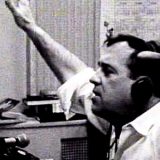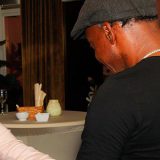Poor Taste
After taping an ill-fated television special in 1969, legendary disc jockey Tom Donahue said of his co-host, Lloyd Thaxton, “The only thing Lloyd did when he opened his mouth was switch feet.” It took nearly half a century, but now I know what Donahue was talking about. That’s my story this week.
I had the opportunity to discuss my syndicated radio feature with Dick, a former general manager of a string of radio stations and currently a professor and head of the School of Journalism and Broadcasting at a southeastern university.
Despite his résumé, Dick is not an ivory tower acolyte nor an empty suit. Like good managers everywhere, Dick got his hands dirty in all parts of the business. You can talk to Dick about ROI or dBm and not faze him in the slightest.
So when I asked Dick for his evaluation of my demo he had two main comments. The first was that it had an NPR feel to it (I get that a lot and I’m proud of it). The second was, shall we say, a little awkward.
Doesn’t Sound Good
He asked me what was wrong with my audio. In fact, his exact comment was, “It sounds as if your microphone and processor are not doing the job for you.”
Wait a minute, Dick. Stick to the script. This evaluation was supposed to be about my concept and the cleverness of my writing.
I hate it when people change the rules.
Okay, I hate it when I change the rules and get caught at it. But, this one was doubly embarrassing.
If you look through the back posts on this humble blog, you’ll notice how many of them deal with questions of audio quality—from choosing the right hardware to editing and processing your audio before you post an episode.
My podcast episodes were always carefully processed to sound good on smartphones and earbuds. They sounded okay on desktops, too, but one has to compromise somewhere, given the breadth of devices used for podcast listening.
But, that was podcasting and this is radio.
Open Wide and Say Ahhh S**t
Audio processing in broadcasting is not a technical decision as much as it is a business one. When it’s done right, listeners can tune across the dial (or hit the SEARCH or SCAN button on a digital radio) and literally tell stations apart from how they sound.
This has little to do with the content and everything to do with how the audio is compressed, filtered, equalized, and shaped. For a given sound, the engineering department takes the raw audio coming out of the studio and passes it through what is called the audio chain to create the station’s sound.
The operative word here is “raw.”
Audio from the studio is unprocessed (or lightly processed). And, that’s what I did to my demo. I used very little processing…just enough to keep the demo from overloading a smartphone. What was I thinking?
Two words come to mind. Show and off.
I was trying to demonstrate that, hey, I know what a station needs in a syndicated show. Like Donahue’s co-host, all I accomplished was planting my foot firmly between my incisors. Then I doubled down on my apparent ignorance by explaining that I knew how to process audio, I just didn’t do it. If I had any hope Dick would mention my demo to some of his colleagues, that was gone. Had Dick been a serious prospect for the show, I would surely have lost a sale.
Be a Wise Guy Not a Wise Guy
Selling the show isn’t about how smart you are , it’s about how professional you are. Showing off isn’t professional. Plus, it takes a day or two to get the taste of smelly feet out of your mouth.
Otherwise, it was an uneventful week.
I played a lot of telephone tag with station managers and PDs looking for feedback. I also processed my demo so it will sound great for the next PD. I’ll dazzle the station engineers later, when I’ve got a signed contract in my pocket.
And my feet on the ground.
[jetpack_subscription_form title=”Get Every Blog Post” subscribe_text=”Enter your address to receive every new post by email.” subscribe_button=”Join Us >>”]









